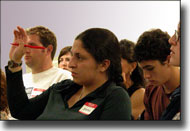“Marketing
and
Negotiating Contract Services”
 This
valuable session zeroed
in on one of the hardest skills we ever need to learn as professionals
— how to make prospective clients or employers understand what
we have to offer, and how to negotiate a mutually satisfying outcome.
Although negotiating is naturally an adversarial process, it need not
be an unpleasant one. This
valuable session zeroed
in on one of the hardest skills we ever need to learn as professionals
— how to make prospective clients or employers understand what
we have to offer, and how to negotiate a mutually satisfying outcome.
Although negotiating is naturally an adversarial process, it need not
be an unpleasant one.
Returning
presenter, independent contractor, and marketing consultant Bruce
Mills (right) provided a series of pointers for use by anyone in
technical communication, graphic design, creative content development,
instruction, Web design, and software development.
Common
negotiating concerns
Before
introducing the evening's guest speaker, Adele Sommers led the meeting
by asking the audience to introduce themselves individually and raise
questions. This was a good way for everyone to get to know one another
and to initiate communication within the group. All participants came
up with great questions; however, negotiating compensation rates was
the most popular topic:
- How to
propose, weigh out, and negotiate creative tradeoffs among pay,
responsibilities, benefits, and other perks; when the merit of doing
work for added experience might justify lower pay
- Where
to begin in the negotiation process; how to master techniques
such as finding a middle ground, “win-win,” and staying open-minded
in the face of objections and resistance
- How to
articulate what you can offer as a value-added advantage over
your competition; convincing others of your skills and getting them
to take your experience seriously (including volunteer work or internships)
- How to
accurately define the scope of a project in the marketing/negotiating
phase and set
a value for individual work components
- How to
negotiate related cost or schedule details such as travel, research,
training, lab time, and time on or off the project; when to take the
cost risk of traveling to discuss a project with unknown parameters
- How to
handle situations that require re-negotiating schedules or costs
resulting from changes in requirements; how best to agree on meaningful
communication lines and responsibilities

What
exactly is negotiating?
Negotiating
is like driving through a four-way intersection. You must see where
your adversaries are going. Negotiating is also like a two-way street;
you cannot assume the other side wants what you want. When the other
parties get what they want (or feel that they have), you will get what
you want. Negotiating includes the following steps:
Process:
You must understand and give your adversary what he or she wants to
get what you want.
-
Get
information and a commitment from your adversary.
-
Adversaries
will not tell you their needs unless they are comfortable.
-
Seek
middle ground for a win-win situation.
-
You
all need to feel like you're getting a deal; otherwise, the process
is failing.
 Techniques: Techniques:
-
Build
a relationship with the adversary before negotiating.
-
Get
a commitment from the adversary. Use the phrase, “If I can give
you _____, will you give me _______?”
-
Sell
your advantage.
-
Manage
gaming tactics.
-
Seek
a higher authority.
-
Do
not compromise your goals.
-
Make
a list of your wants and their wants. Compare the lists to see if
the project is worth it.
-
What
do you want that will make you feel satisfied?
-
If
you give up one of your wants, you have to get something.
-
Know
when you will walk away.
-
If
you cannot get a commitment, negotiations are over.
-
Build
a relationship in order to lead to a commitment.
Keys
for a successful negotiation:
-
Stick
to the process outlined above.
-
Plan.
-
Employ
proven techniques.
-
Know
beforehand what you are willing to do to get what you want.
-
It
is important to differentiate your product from someone else's, because
often, that's the determining factor.
-
Be
prepared for surprises.
-
How
do you negotiate compensation? Research average salary data in advance.
It
depends on your demographics, experience, and field. [Note: See
Web Resources below.]
-
It
is good to run into objections during a negotiation because you can
get more information on what your adversary wants.
You
can apply many of these techniques regardless of whether you freelance
or work for an employer. Most marketing and negotiation skills are universal!
|
1)
Click to open or download Bruce's
complete presentation (98K PDF file).
2)
Click to open or download Bruce's handout: Tips
and Techniques for Successful Negotiating (24K PDF file)
3)
Click to open or download Bruce's handout: Improving
Your Marketing & Negotiating Skills (32K PDF file)
from the follow-on (May 19th) telephone seminar
4)
Video and audio recordings:
5)
Web resources:
- See
Salary.com
for excellent free and fee-based information on salaries and
compensation packages in any field and region, derived from
a huge database of demographic data.
6)
Bruce's recommended reading list, and more:
- The
New Strategic Selling: The Unique Sales System Proven Successful
by the World's Best Companies, Revised and Updated,
Robert B. Miller & Stephen Heiman, Miller-Heiman Inc. (1998,
ISBN: 0446673463)
- You've
Got to Be Believed to Be Heard, Bert Decker, St. Martin's
Press (reissue edition, 1993, ISBN: 0312099495)
- Winning
the Race for Value: Strategies to Create Competitive Advantage
in the Emerging "Age of Abundance," Sheely,
Bracey & Frazier, American Management Association (1996,
ASIN: 0814403549)
- When
the Other Guy's Price Is Lower: You Can Still Make the Sale,
James M. Bleech & David G. Mutcher, Leadership Development
Center - Lifetime Books (1996 ASIN: 0811908119)
- How
to Make it Big as a Consultant, 3rd edition, William
A. Cohen, American Management Association (2001, ISBN: 0814470734)
- Consultative
Selling: The Hanan Formula for High-Margin Sales at High Levels,
7th edition, Mack Hanan, American Management Association (2003,
ISBN: 081447215X)
- The
Fast Forward MBA in Project Management: Quick Tips, Speedy Solutions,
and Cutting-Edge Ideas, Eric Verzuh, The Portable MBA
Series, John Wiley & Sons (1999, ISBN: 0471325465)
- The
Product Manager's Handbook: The Complete Product Management
Resource, 2nd edition, Linda Gorchels, NTC Publishing
Group (2000, ISBN: 0658001353)
- Getting
to Yes: Negotiating Agreement Without Giving In, 2nd
edition, Roger Fisher & William Ury (1991, ISBN: 0140157352)
- The
Business Side of Creativity
by Cameron S. Foote (2002, ISBN: 039373093X)
|
Photography
by Mary Meyer and Michael Raphael.
|